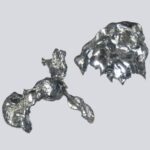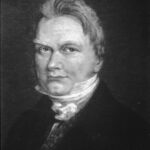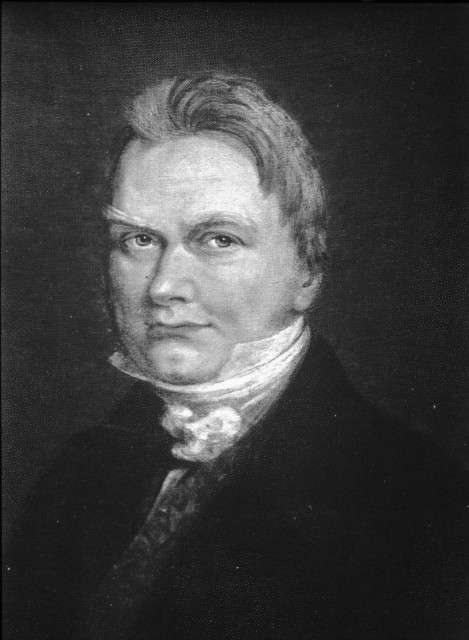The discovery of a new chemical element is a rare event now. In fact, new elements are not discovered, they are made by smashing smaller nuclei of atoms together. The most recent new element to be recognised and named is Oganesson, atomic number 118. It is the new bottom member of the Noble Gas group.
In the early nineteenth century things were a bit different. Lavoisier’s new system of chemistry and Dalton’s Atomic Theory gave chemists a new incentive for searching for new elements. New methods such as electrolysis provided ways to extract the elements from compounds. Sometimes the eagerness of chemists to discover and name new elements lead to mistakes but 1817 was a good year for element discovery, with three new elements that have passed the test of time. They were cadmium (Cd), lithium (Li) and selenium (Se). At first they were merely of interest to the element hunters but today all three are significant elements.
Cadmium
Friedrich Stromeyer was born in 1776. He studied chemistry at the University of Gottingen in Germany and afterwards became a professor there. He had another job as inspector of apothecaries (shops that sold medicines like today’s pharmacies).
Zinc oxide, known as calamine, is used medically to reduce the itching from sunburn and insect bites. Zinc oxide was made by heating zinc carbonate obtained from minerals. Stromeyer found that some apothecaries were selling zinc carbonate instead of zinc oxide. The apothecaries said this was because the zinc oxide they made was yellow (zinc oxide is usually yellow only when it is hot) and customers didn’t want to buy it. Stromeyer investigated the zinc carbonate they were using and found that it contained an impurity which he identified as a compound of a new element, cadmium. The name comes from an old word for zinc oxide.

Cadmium is a soft metal in the same group in the Periodic Table as zinc and mercury. It occurs as an impurity in zinc ores and can be separated out when zinc is extracted. Cadmium has a low melting point and, when mixed with other metals, the alloys also have very low melting points. One cadmium alloy called Wood’s metal has a melting point of 70oC. It is used as plugs in the outlets of fire sprinkler systems. In a fire, the alloy plug melts releasing the water.
Cadmium was also used to electroplate steel with a thin layer of the metal to prevent rusting. This use has ceased because cadmium is poisonous with a long list of symptoms for anyone who ingests it. In the last 60 years however another very important use for cadmium was found – the nicad battery. It has electrodes of cadmium and nickel in an electrolyte of potassium hydroxide and is rechargeable. First invented in 1899 nicad batteries produce more electrical power for a given weight than lead-acid batteries and can be recharged many times. From the 1960s, sealed nicad batteries began to be used in many electrical appliances including power- tools and laptop computers. While safe in normal use, nicad batteries have proved difficult to dispose of. If thrown on to landfill sites the cadmium escaped, poisoning the environment. Nicad batteries are now banned in new appliances in Europe but, in any case, have been replaced by nickel-metal hydride and lithium-ion batteries which are less toxic and more powerful.
Lithium
Johan August Arfwedson was born into a rich Swedish mining family in 1792. He studied chemistry and joined Berzelius’ laboratory in Stockholm. Arfwedson was given some minerals to study which had been discovered by two Brazilians travelling through Sweden. The minerals were thought to be mainly potassium carbonate but they had some unexpected properties. Arfwedson succeeded in separating out a compound of a new element. It was similar to sodium and potassium, the alkali metals, which are present in seawater but unlike them its carbonate was quite insoluble. As the new element appeared to be found in rocks and not in seawater it was given the name lithium from the Greek word for stone, lithos.
Humphry Davy, the Director of the London Royal Institution, who had used electrolysis to extract sodium, potassium and other metals, soon applied his method to separating lithium from lithium oxide. It is a soft, reactive metal, though less so than sodium, and gives a red colour to a flame. Lithium is the first metal in the Periodic Table (atomic number 3) and has the lowest density of any metal. Some of the atoms of lithium found on Earth today were formed in the Big Bang 13.8 billion years ago.
Lithium and its compounds have some interesting properties and uses, for example lithium oxide is used in CO2 absorbers in space vehicles and as a drug to treat bipolar disease, but it did not have a large-scale application until recently. Now the future seems to depend on lithium batteries.
Lithium-ion batteries were developed from the 1970s and went into production in 1991. The electrodes consist of lithium cobalt oxide and a lithium/graphite mixture. The reaction in the battery can be reversed, so, like a nicad battery, they are rechargeable. The great advantage of lithium-ion batteries is that they store six times as much energy per kilogram as a lead-acid battery and twice as much as a nicad battery. They can be recharged repeatedly but need to be managed carefully to avoid damage. Although not poisonous like nicad batteries, lithium is highly flammable so the casing must not be broken.

Lithium-ion batteries now power most of our personal devices – mobile phones, laptops, tablets, etc. – but these are relatively small appliances. As they pack so much power into a small mass they are also used in the new range of electric vehicles such as the Tesla. Electric vehicles need much bigger batteries than a mobile phone. As sales of electric cars grow there is a huge growth in demand for lithium. Some people say variations of the lithium battery will be the petrol of the future but, although it is theoretically reusable, finding sufficient stocks of the metal is a problem.
Selenium
Jons Jacob Berzelius had a hand in a lot of chemical discoveries but the discovery of selenium is his alone. He was born in 1879 in Sweden. His father was the principal of a school but both his parents died when he was young and he was brought up by his stepfather who was a vicar. He went to Uppsala university to study medicine but had a break in his studies caused by lack of money and became a private tutor for a short while. He was already carrying out chemical and electrical experiments and making discoveries. These eventually brought him a position at an Institute in Stockholm where he could devote all his time to research. Berzelius’ work and the textbook he wrote were known throughout Europe.

In 1817 Berzelius was asked to help solve some problems that a sulfuric acid factory in Sweden was having. Workers were becoming ill and the sulfuric acid had a red tinge. The process used at that time started with copper pyrites (a form of copper sulfide). Berzelius investigated the ores and the sludge left over in the plant, expecting the problem to be impurities containing tellurium. Instead he found compounds of a new element with properties similar to sulfur and tellurium. As the name of tellurium comes from the Latin word for Earth, Berzelius named the new element after the Moon (Selene).
Selenium has the unusual property of being sensitive to light. Its electrical resistance decreases as the intensity of light on it increases. It was used in light sensors and photocopiers but has now been replaced by other materials although it is still used in thin-film solar cells. Most selenium is used in making glass, giving it a red tinge.
The biological effects of selenium were noticed by Berzelius who found it gave him bad breath as tellurium does. It is toxic but recently it has been found to be essential to life and an important trace element in our diet. This discovery was made by Jane Gibson at the Lister Institute at the University of London in 1954. Selenium atoms are a vital component of the enzymes that are active in the thyroid gland which controls metabolism. Selenium additives and selenium rich foods have become one of the latest diet crazes. Adults need about 60 micrograms of selenium a day. Brazil nuts are the best source; one nut a day is enough to give you the full daily requirement but there is usually sufficient in an average day’s meals.
Activities
- Of the elements discovered in 1817 which is a. A non-metal, b. A transition metal or c. An alkali metal
- Find the three elements on the Periodic Table. Make an information card for each element with facts about its discovery, atomic structure, properties and uses.
- All the discoverers of these elements were examining a material for impurities. Explain why cadmium is found in some zinc ores, lithium with potassium carbonate and selenium in sulfide ores of copper.
- Some of the uses of the elements have been mentioned in the article. Find out what other uses they have.
- All three of these elements have their dangers. Discuss the risk in using the elements for their major uses. Does the importance of the application outweigh the safety issues?
- If we are going to make use of these elements they must be obtained from somewhere – usually rocks. What implications are there for the environment of making greater use of these elements, particularly lithium, in the future?
Bibliography.
A History of Chemistry vol IV, J R Partington, Macmillan 1964
Cadmium http://www.chemistryexplained.com/elements/A-C/Cadmium.html
Friedrich Stromeyer http://dbpedia.org/page/Friedrich_Stromeyer
Nicad batteries https://en.wikipedia.org/wiki/Nickel%E2%80%93cadmium_battery
Lithium https://www.webelements.com/lithium/history.html
Lithium-ion batteries https://en.wikipedia.org/wiki/Lithium-ion_battery
Selenium http://www.news-medical.net/health/Selenium-History.aspx
Jane Gibson https://en.wikipedia.org/wiki/Jane_Gibson
Selenium in foods https://ods.od.nih.gov/factsheets/Selenium-HealthProfessional/
Photo sources.
Cadmium: https://commons.wikimedia.org/wiki/File:Pure_cadmium._Original_size_of_each_piece_in_cm_-_about_1.jpg
Jons Jacob Berzelius: https://commons.wikimedia.org/wiki/File:J%C3%B6ns_Jacob_Berzelius.jpg
Telsa: https://pl.wikipedia.org/wiki/Tesla_Inc.
Peter Ellis



